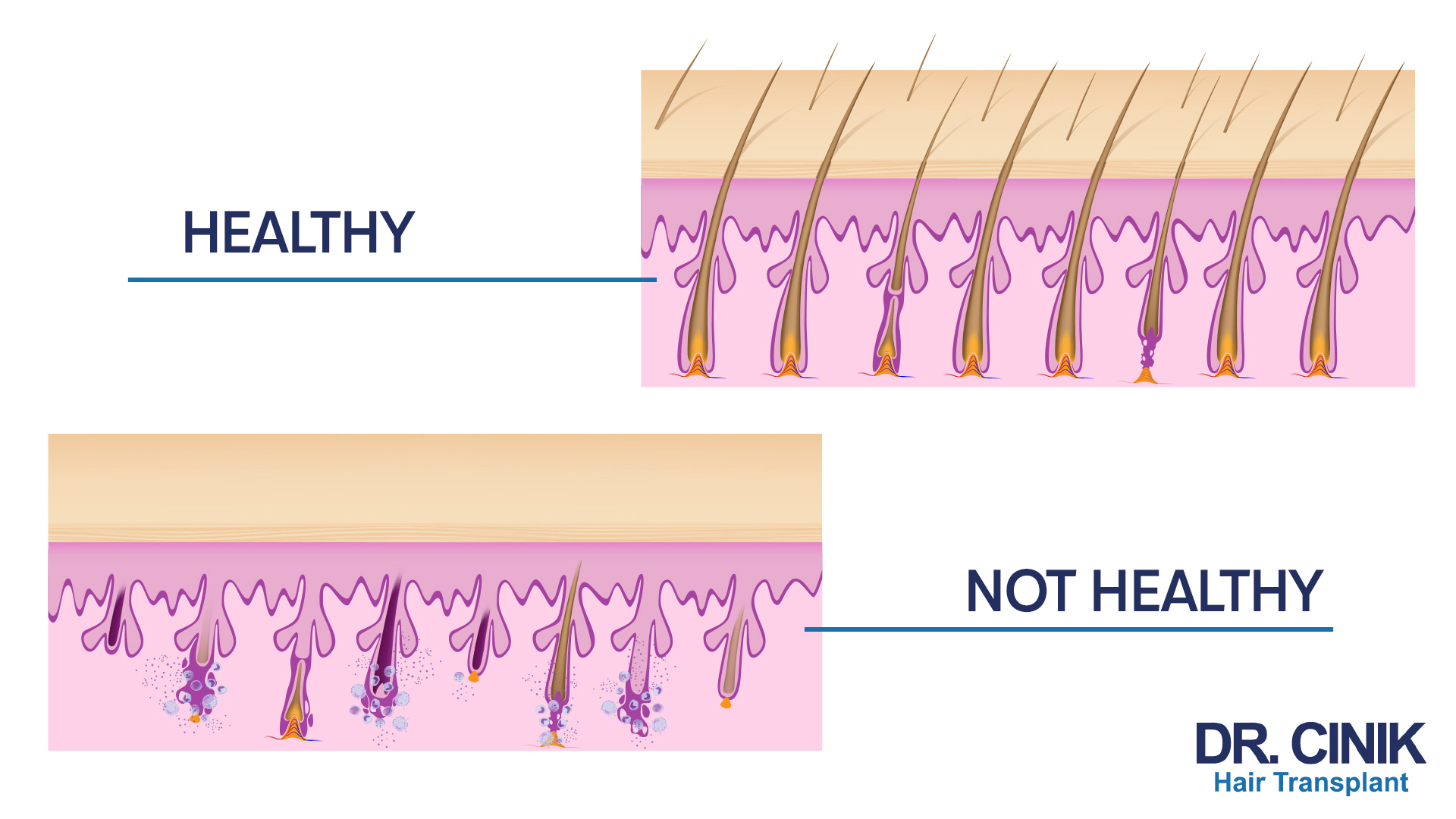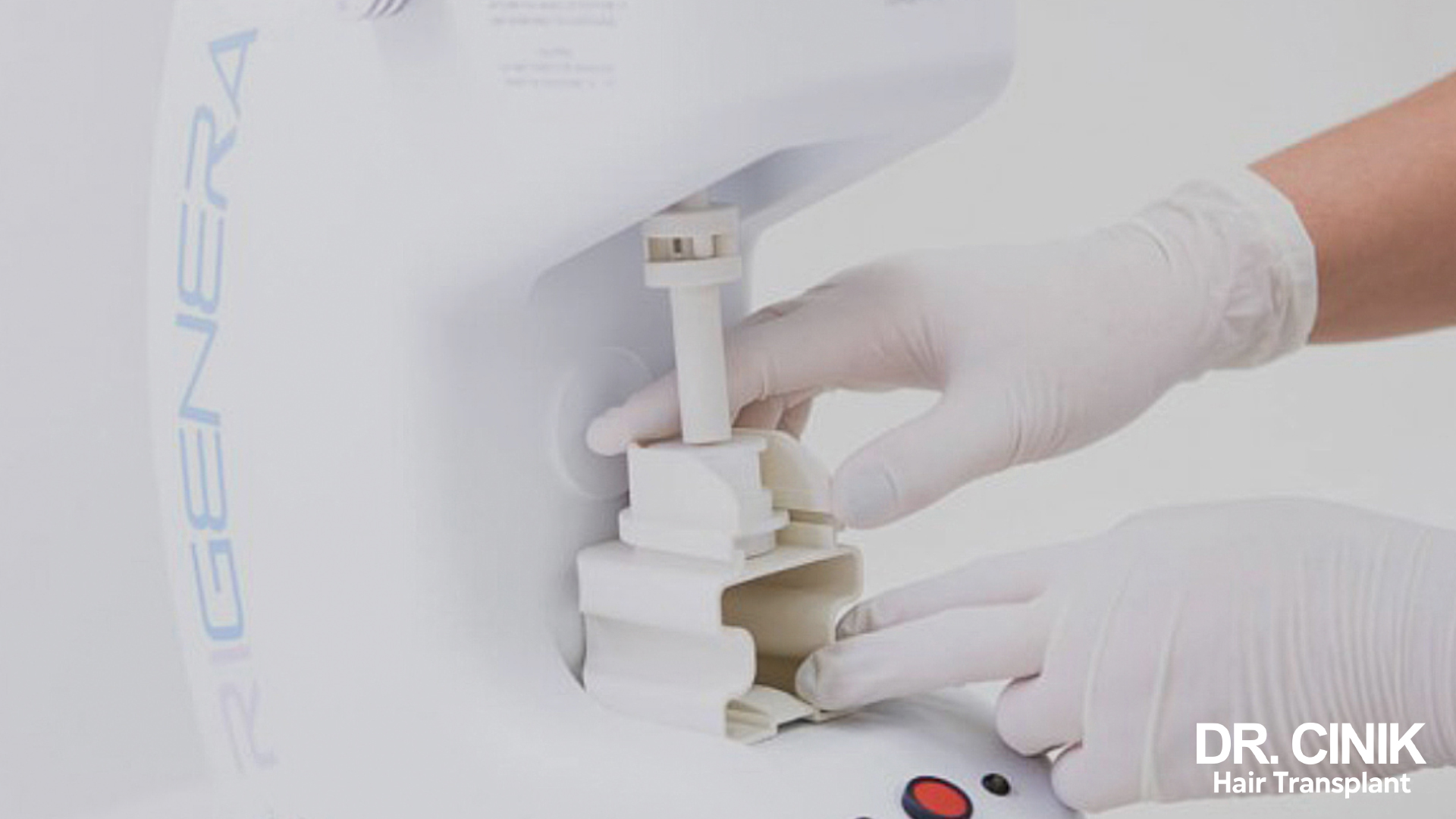Thinning hair: understand the causes and act in time

Sommaire
If you’ve noticed your hair thinning and your scalp becoming more visible, you’re not alone. In the vast majority of cases, this is the first sign of androgenetic alopecia, also known as pattern baldness – a progressive form of hair loss with a genetic component.
When hair starts to thin due to androgenetic alopecia, the process of hair loss has begun and is often irreversible. However, the progression is typically very gradual, sometimes taking years or even decades.
Fortunately, there are now many solutions available to slow the thinning and loss of hair caused by androgenetic alopecia. From topical treatments and anti-hair loss supplements to mesotherapy, the options are numerous. Implementing them at the first signs can help preserve hair density for as long as possible.

In more advanced stages, when medical treatments are no longer sufficient, hair transplantation is the go-to solution for regaining a full head of hair. This surgical procedure allows for the redistribution of the remaining hair in a natural and permanent way.
This article provides an overview of hair thinning linked to androgenetic alopecia: the underlying mechanisms, the telltale signs, and the various treatment options based on the stage of progression. The goal is to help you understand this process and implement a personalized strategy.
What is androgenetic alopecia, the main cause of thinning hair?
Androgenetic alopecia is the most common form of hair loss, affecting both men and women, though it manifests differently between the sexes. This condition arises from a combination of genetic and hormonal factors.

A genetic predisposition to sensitivity to androgens
The foundation of androgenetic alopecia is a genetic predisposition that makes hair follicles more sensitive to the effects of androgenic hormones, primarily dihydrotestosterone (DHT). This heightened sensitivity is genetically inherited, which explains why pattern baldness often runs in families.
Studies00125-5/abstract) have identified multiple genes involved in this process, located on both the X chromosome (inherited from the mother) and the autosomes (inherited from both parents). The expression of these genes can differ between individuals, influencing the age of onset and severity of hair loss.

The central role of dihydrotestosterone (DHT) in hair follicle miniaturization
DHT is a byproduct of testosterone, produced by an enzyme called 5-alpha-reductase. In genetically predisposed individuals, DHT binds to the receptors in hair follicles and gradually impairs their function.
Under the influence of DHT, the hair growth cycle is disrupted: the growth phase (anagen) shortens, while the resting phase (telogen) lengthens. Over successive cycles, the hair follicle produces progressively finer and shorter hairs, until they eventually become vellus hairs (fine, short, non-pigmented hairs). In the end, the follicle may atrophy completely, leaving only an empty pore on the scalp surface.

The different stages of androgenetic alopecia and their progression
In men, androgenetic alopecia typically advances through several stages, as described by the Hamilton-Norwood scale:
- Stages I and II: Beginning of recession of the frontal hairline and temporal areas
- Stages III and IV: Deepening of temporal recession and thinning of the vertex
- Stages V and VI: Worsening hair loss, with the recession areas joining the thinning crown
- Stage VII: Extensive hair loss with only a horseshoe-shaped band of hair remaining

The specifics of female pattern hair loss
In women, androgenetic alopecia typically manifests as diffuse thinning over the scalp, most prominently at the crown, but with preservation of the frontal hairline. The Ludwig classification defines 3 stages of increasing severity.
The progression is often slower than in men, and complete baldness is rare. However, the decrease in hair density can still be quite significant and a source of considerable psychological distress.
In women, androgenetic alopecia can be exacerbated by certain hormonal conditions such as menopause or polycystic ovary syndrome (PCOS). Therefore, exploring the underlying causes of hair loss is particularly important for female patients.

The biological basis of thinning hair: from follicle to strand
To fully grasp the process of hair thinning, it’s useful to review how the hair follicle works. This small structure within the skin is what gives rise to hair.
The hair follicle growth cycle and its role in hair growth
Each hair follicle goes through a growth cycle consisting of three phases:
- The anagen phase, lasting 2 to 6 years, is the stage of active hair growth. During this time, the hair lengthens at a rate of about 1 cm per month.
- The catagen phase, lasting 2 to 3 weeks, is a transitional stage during which the follicle stops growing.
- The telogen phase, lasting 2 to 4 months, is a resting stage after which the old hair sheds to make way for a new one.
This cycle repeats an average of 25 times over our lifetime, constantly renewing our hair.

How androgens impact the hair cycle: shortening the anagen phase
In androgenetic alopecia, the hormone DHT disrupts the normal course of the follicle growth cycle. Under its influence:
- The growth (anagen) phase gradually shortens, so the hair becomes progressively shorter.
- The resting (telogen) phase tends to lengthen, delaying the start of a new growth cycle.
- The proportion of follicles in the growth phase decreases, while the percentage in the resting phase increases.
As a result, hair becomes sparser, first through individual strands becoming thinner, and then through an overall decrease in hair count.

The gradual miniaturization of the follicle and hair shaft
Simultaneously, DHT causes the hair follicle to progressively shrink. Under the effect of the hormone, the follicle atrophies, producing increasingly finer hairs.
There is a gradual transition from thick, terminal hairs (diameter over 0.06 mm) to fine, vellus-like hairs resembling down (diameter under 0.03 mm), which are often depigmented.

Progression to vellus hair and potential permanent loss
If the process continues unchecked, the hair follicle may atrophy completely. At this stage, it stops producing hair entirely, leaving an empty pore on the scalp surface.
Unfortunately, at this point the loss is permanent. A hair transplant procedure is then the only way to restore hair to the area.
In summary, hair thinning is a direct consequence of DHT acting on the hair follicle. By disrupting its growth cycle and causing it to progressively shrink, this hormone compromises the follicle’s ability to produce thick, healthy hair. Understanding these mechanisms is key to implementing appropriate and effective hair loss treatments.

Medical treatments for androgenetic alopecia to slow thinning
When good hair care habits are no longer sufficient to slow down thinning, your dermatologist may recommend medical treatments. These aim to block the damaging effects of androgens on the follicle and extend the hair growth phase.
Finasteride and minoxidil – caution advised
Finasteride and minoxidil are two medications frequently suggested for treating androgenetic alopecia in men and women respectively. While they can help slow hair loss and promote regrowth, their use requires careful oversight due to potential side effects.
Finasteride works by blocking the conversion of testosterone to DHT. However, it can cause sexual side effects (decreased libido, erectile dysfunction), psychiatric symptoms (depression, anxiety), or gynecomastia. Close monitoring is necessary for the duration of treatment.

Minoxidil, on the other hand, may lead to scalp irritation, skin dryness, or hypertrichosis (excessive hair growth) on the face and body. Its long-term use must be medically supervised.
Given these possible side effects, it’s crucial to discuss the risk-benefit balance of these treatments with your dermatologist, based on your individual situation. Alternative therapies may be preferred as first-line options.
Hair mesotherapy: PRP, LLLT, Regenera Activa
In recent years, innovative localized therapies have shown promise in stimulating the hair follicle and reactivating hair growth.
These cutting-edge therapies include:
- Platelet-rich plasma (PRP): Prepared from a sample of your own blood, PRP contains a high concentration of platelets and growth factors. Injected into the scalp, it directly stimulates the follicle and promotes hair regrowth.

- Low-level laser therapy (LLLT): Exposing the scalp to cold laser light helps stimulate cellular metabolism and blood microcirculation around the follicles. LLLT thus encourages hair growth and increases hair density.

- The Regenera Activa technique: This procedure involves taking a small skin sample from the scalp, extracting the stem cells, and reinjecting them into the areas of thinning. These stem cells regenerate hair follicles and reactivate hair growth long-term.

These therapies are usually performed as a treatment course, at a frequency determined by your specialist based on your individual case. They can yield substantial improvements in hair density and quality, without the side effects associated with traditional drug treatments.

Hair transplantation – a last resort for advanced hair loss
When androgenetic alopecia reaches an advanced stage and medical treatments are no longer adequate, hair transplantation can be an effective and lasting solution to restore a full head of hair. There are several hair transplant techniques:
- Follicular unit extraction (FUE) is a modern, minimally invasive grafting technique. It involves harvesting hair follicles one by one from the donor area (back of the head) and reimplanting them in the thinning or bald areas. The grafts, containing 1 to 4 hairs each, are taken from follicles that are resistant to DHT, ensuring a long-lasting result.

- Direct hair implantation (DHI) is a variant of FUE where the grafts are reimplanted immediately after harvesting, without an intermediary step. This allows for better graft hydration and reduces the overall procedure time.

In both cases, the implantation follows a predefined pattern to recreate a natural-looking hairline. The density and angle of the implanted hairs are personalized for each patient.

 en
en



